Influence of sustainable agricultural practices on chemical properties of vertisol soil with Soybean-Wheat cropping sequence
R.K. Tenguria1 * and K. Menaria1
1
Division of Microbiology, Department of Botany,
Government Motilal Vigyan Mahavidyalaya,
Bhopal,
462 002
India
DOI: http://dx.doi.org/10.12944/CWE.3.1.26
The present study is one step towards sustainable agricultural practices. The results observed for chemical properties like pH, electrical conductivity, available nitrogen, available phosphorus, available potassium, available sulphur, zinc content, organic carbon content and organic matter of vertisol soil indicated that these properties were significantly enchanced at different stages of Soybean and Wheat growth on the application of different IPNM treatments. The best results were observed with T7 treatment (100% NPK+FYM). The incorporation of different IPNM treatment has also showed that IPNM treatments have significantly leading to the improved chemical properties of soil.
Copy the following to cite this article:
Tenguria R.K, Menaria K. Influence of sustainable agricultural practices on chemical properties of vertisol soil with Soybean-Wheat cropping sequence. Curr World Environ 2008;3(1):167-174 DOI:http://dx.doi.org/10.12944/CWE.3.1.26
Copy the following to cite this URL:
Tenguria R.K, Menaria K. Influence of sustainable agricultural practices on chemical properties of vertisol soil with Soybean-Wheat cropping sequence. Curr World Environ 2008;3(1):167-174. Available from: http://www.cwejournal.org/?p=797
Download article (pdf)
Citation Manager
Publish History
Select type of program for download
| Endnote EndNote format (Mac & Win) | |
| Reference Manager Ris format (Win only) | |
| Procite Ris format (Win only) | |
| Medlars Format | |
| RefWorks Format RefWorks format (Mac & Win) | |
| BibTex Format BibTex format (Mac & Win) |
Article Publishing History
| Received: | 2008-04-18 |
|---|---|
| Accepted: | 2008-06-05 |
Introduction
Taxonomically, soils of Madhya Pradesh are divided into four orders such as Inceptisols (27.65%), Entisols (12.97%), Vertisols (52.57%) and Mollisols (0.41%). This shows that soils of MP are rich vertisol type. The vertisol/black cotton soil is originated from lation word verto which means turn (Murthy et al., 1982). This order of mineral soils is characterized by high content of swelling type clays, which in dry seasons cause the soils to develop deep, wide cracks. The water holding capacity of this soils is high. The bulk density generally varies between 1.2 and 1.6 M gm-3. The main constraints of this soil are low infiltration capacity and poor internal drainage, narrow workable soil water range, poor crop stand, evaporation from soil surface and shrinkage cracks. For these contratins the balanced and integrated use of plant nutrients as per soil value is the best strategy to maintain the soil health and crop productivity and yield. Therefore keeping these ideas in mind the present investigation "Influence of sustainable agricultural practices on chemical properties of vertisol soil with Soybean crop in Soybean-Wheat cropping sequence" was undertaken at Sehore district to represent the Central India.
Material and Methods
A field experiment was conducted during two consecutive years i.e. 2003-04, 2004-05 in the Rabi season respectively in medium black soil (vertisol) on "Influence of sustainable agricultural practices on chemical properties of vertisol soil with Soybean crop in Soybean-Wheat cropping sequence". The treatment applied to soil were Control (T1), 100% NPK (T2), 75% NPK (T3), 50% NPK (T4), 50% NPK+FYM (T5), 100% NPK+FYM (T6), 100% NPK+FYM (IPNM) (T7). The treatments were replicated thrice in randomized block design (RBD). The Soybean CV JW-335 and the wheat CV GW - 273 variety was used for experiments. To study the chemical properties of soil, the soil samples were taken from 0-15, 15-30, 30-45cm depth before the sowing of the test crop from each plot. Further, these samples were mixed and a representative composite sample was prepared. It was air dried and processed with wooden pestle and mortar and passed through 2 mm sieve. It was stored and used for chemical analysis. The pH and electrical conductivity of soil was measured by Solubridge method (Piper, 1967) for this 1:2 soil water suspension solution was prepared and kept for over night and next day after method (Subbiah and Asija, 1956) was used for the estimation of available nitrogen. The Olsen's method (Olsen et al., 1954) was used for the determination of available phosphorus. The potassium content was measured during study using flame photometric method (Toth and Prince, 1949). In the present study Barium Chromate method was used (Palaskar et al., 1981) for the estimation of sulphur. The Zinc (Zn) content was determined by using the method given by Lindasy and Norvell (1978). Where as the organic carbon and organic matter was determined by Walkley and Black method (1934).
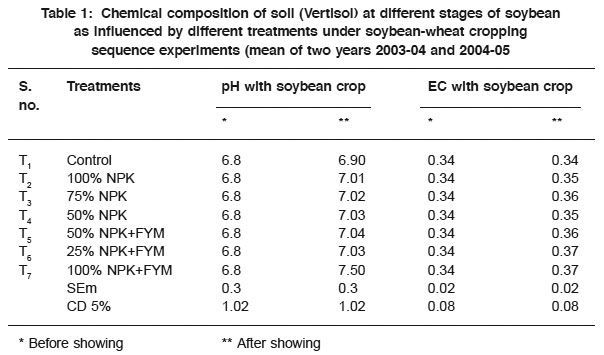 |
Table 1: Chemical composition of soil (Vertisol) at different stages of soybean as influenced by different treatments under soybean-wheat cropping sequence experiments (mean of two years 2003-04 and 2004-05 Click here to view table |
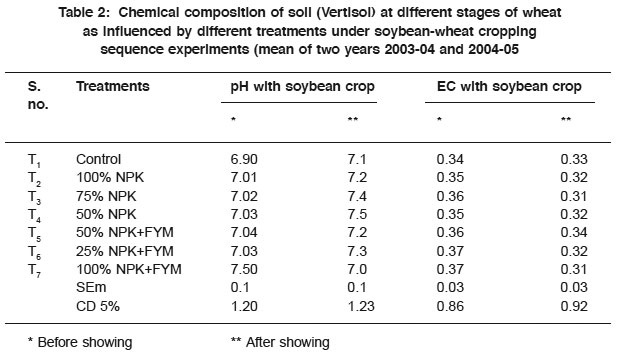 |
Table 2: Chemical composition of soil (Vertisol) at different stages of wheat as influenced by different treatments under soybean-wheat cropping sequence experiments (mean of two years 2003-04 and 2004-05 Click here to view table |
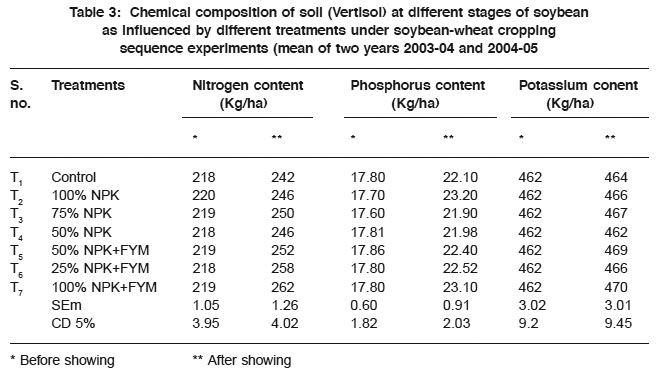 |
Table 3: Chemical composition of soil (Vertisol) at different stages of soybean as influenced by different treatments under soybean-wheat cropping sequence experiments (mean of two years 2003-04 and 2004-05 Click here to view table |
Results and Discussion
The pH of soil before experimentation with soybean crop was 6.86. After harvesting the pH values were observed minimum with T1 (control) and the maximum with T7 (100% NPK + FYM) (Table 1 and Fig. 1). The pH values for wheat crop before experimentation were the same as after soybean crop. The pH of soil after harvest showed the minimum value for T7 (100% NPK + FYM) and maximum with T4 (50% NPK) (Table 2 and Fig. 2). The EC of soil before experimentation with soybean crop was 0.34. After harvesting the EC values were found minimum for T1 (control) and maximum with T7 (100% NPK + FYM) (Table 1 and Fig. 1). The EC of soil before experimentation with wheat crop was the same as after harvest of soybean crop. After hasvesting the EC values were minimum for T3 (75% NPK) and T7 (100% NPK + FYM) while the ma maximum was with T5 T4 (50% NPK + FYM) (Table 2 and Fig. 2). The nitrogen content in soil before experimentation with soybean crop was 218.0 kg ha-1. After harvesting the available nitrogen content was minimum observed with T1 (control) while the maximum T7 (100% NPK + FYM) (Table 3 and Fig. 1). The available nitrogen of soil before experimentation with wheat crop was the same as after harvest of soybean crop. After harvesting available nitrogen content was minimum observed with T1 (control) and the maximum for T7 (100% NPK + FYM) (Table 4 and Fig. 2). The phosphorus content in soil before experimentation with soybean crop was 17.80 kg ha-1. After harvesting the available phosphorus was observed minimum with T3 (75% NPK) while the maximum with T7 (100% NPK + FYM) (Table 3 and Fig. 1).
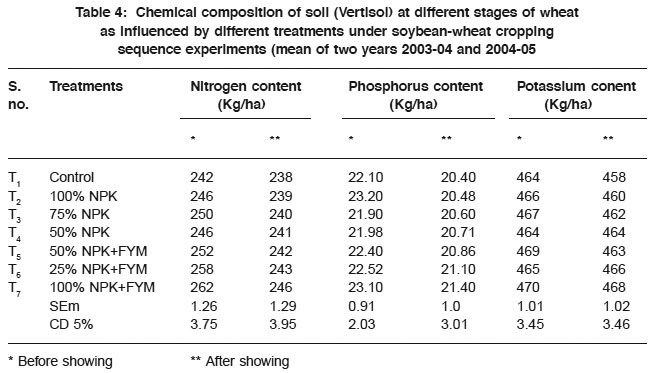 |
Table 4: Chemical composition of soil (Vertisol) at different stages of wheat as influenced by different treatments under soybean-wheat cropping sequence experiments (mean of two years 2003-04 and 2004-05 Click here to view table |
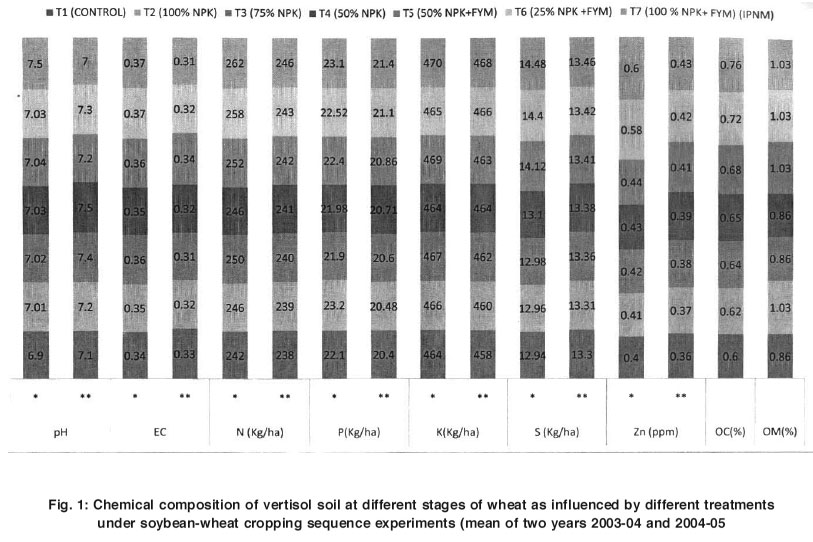 |
Figure 1: Chemical composition of vertisol soil at different stages of wheat as influenced by different treatments under soybean-wheat cropping sequence experiments (mean of two years 2003-04 and 2004-05 Click here to view figure |
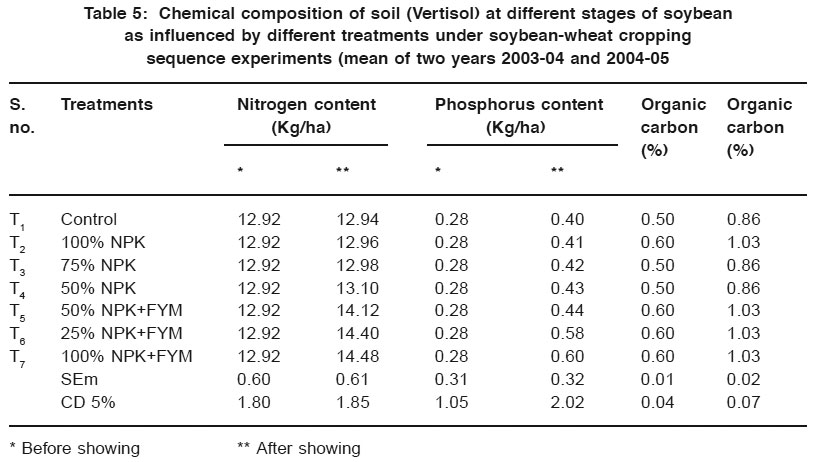 |
Table 5: Chemical composition of soil (Vertisol) at different stages of soybean as influenced by different treatments under soybean-wheat cropping sequence experiments (mean of two years 2003-04 and 2004-05 Click here to view table |
The available phosphorus content in soil before experimentation with wheat crop was observed minimum with T3 (75% NPK) and the maximum with T7 (100% NPK + FYM). After harvesting the crop phosphorus content values were observed minimum with T1 (control) and the maximum T7 (100% NPK + FYM) (Table 3 and Fig. 1). The potassium content in soil before experimentation with soybean was 462.0 kg ha-1. After harvesting the available potassium values was observed with T1 (control, T4 (50%NPK) and the maximum with T7 (100% NPK + FYM). After harvesting potassium content was noticed minimum (control) and the maximum was with T7 (100% NPK+FYM) (Table 4 and Fig. 2). The sulphur content in soil before experimentation with soybean crop was 12.92 kg ha-1. After harvesting the available potassium values was observed with T1 (control) while the maximum T7 (100% NPK + FYM). After harvesting the available potassium values was observed with T1 (control) and the maximum T7 (100% NPK + FYM) (Table 5 and Fig. 1). The sulphur content in soil before experimentation with wheat crop was minimum with T1 (control) and the maximum T7 (100% NPK + FYM). After harvesting sulphur content was observed minimum with T1 (control) and the maximum was with T7 (100% NPK + FYM) (Table 6 and Fig. 2). The zinc in soil before experimentation with soybean crop was 0.28 ppm. After harvesting the available zinc value wasobserved minimum with T1 (control) while the maximum with T7 (100% NPK + FYM) (Table 5 and Fig. 1). The zinc content in soil before experimentation was observed minimum with T1 (control) while the maximum T7 (100% NPK + FYM). After harvesting zinc content values were observed minimum with T1 (control) and the maximum was with T7 (100% NPK + FYM) (Table 6 and Fig. 2). The data obtained on organic carbon for soybean crop were observed minimum for T1 (control) and the maximum was for T7 (100% NPK + FYM) (Table 6 and Fig. 2). The data obtained or organic matter for soybean crop the minimum values were observed for T1 (control) while the maximum was T7 (100% NPK + FYM) (Table 5 and Fig. 1). The data obtained for the organic matter in soil with wheat crop were noticed minimum with T1 (control) while the maximum with T7 (100% NPK + FYM) (Table 6 and Fig. 2).
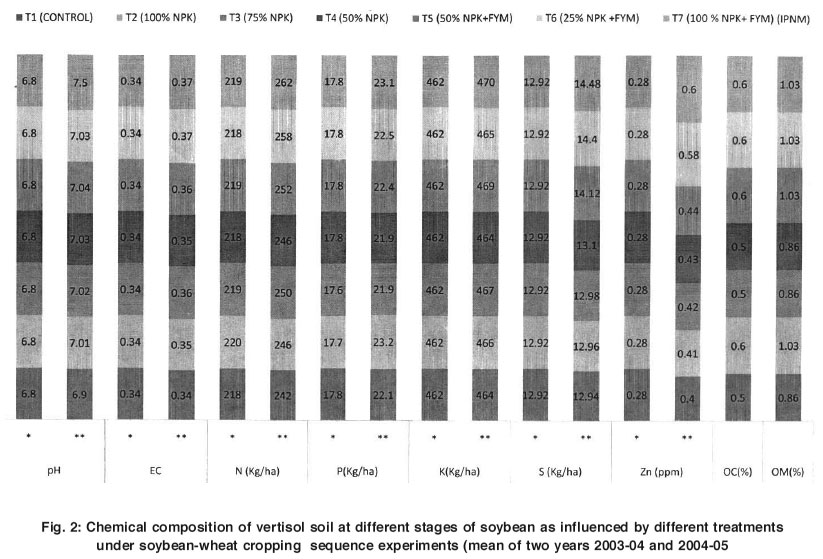 |
Figure 2: Chemical composition of vertisol soil at different stages of soybean as influenced by different treatments under soybean-wheat cropping sequence experiments (mean of two years 2003-04 and 2004-05 Click here to view figure |
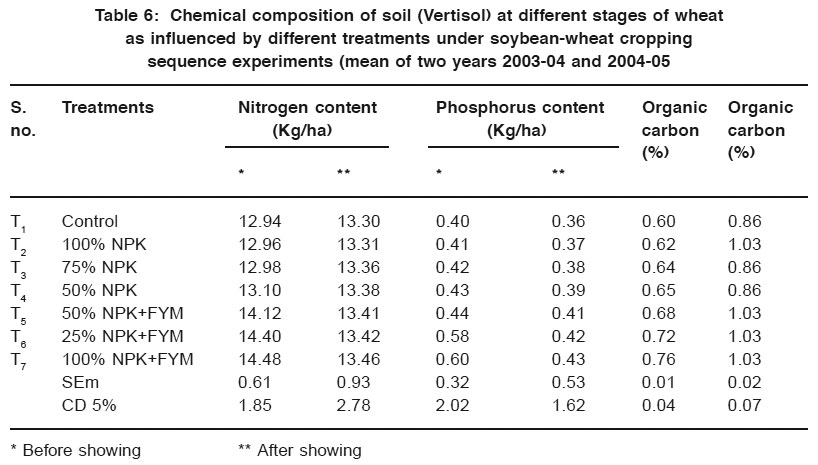 |
Table 6: Chemical composition of soil (Vertisol) at different stages of wheat as influenced by different treatments under soybean-wheat cropping sequence experiments (mean of two years 2003-04 and 2004-05 Click here to view table |
As per data shown in tables N, P and K contents were significantly influenced at different stages of soybean and wheat crops in all the treatments the maximum with impact was noticed with T7 treatments increased in contents may be due to the application of different IPNM treatments. Like wise sulphur and zinc contents were significantly increased with different doses. This was due to synergistic relationship between potassium with sulphur and zinc. The data obtained on organic carbon and organic matter indicated that these contents were significantly influenced by different IPNM treatments over that of control. The T2, T5, T6 and T7 treatment were found to be statistically at par.
These results are in close agreement with those obtained by Rajput and Sastry (1988a, 1988b), Jain and Vyas (2003). The increasing trend in organic carbon and organic matter contents could be ascribed due to the addition of FYM in the soil and the added crop residues during the growth period of soybean leading to the enchanced organic carbon and organics matter content after harvest of crop in the soil.
References
- Jain, R.C. and Vyas, M.D., Improvement of component of agro-technologies for management of intercrops. In. National agricultural technology project completion report. April 2000-Dec-2003, (2003) 1-31.
- Lindsay, W.L. and Norvell, W.A., Development of DTPA soil test for zinc, manganese and copper., Soil Sci. Soc. Am. J., (1978) 42: 421-428.
- Murthy, R.S., Bhattacharyee, J.C., Lande, R.J. and Pofali, R.M., Distribution, characteristics adn classification of verticals. Trans. In. 12th Internation Congress Soil Science, New Delhi, Symposium Paper - II, (1982) 3-22.
- Olsen, S.R., Cole, C.V., Watanabe, F.S. and Alan, L.A., Estimation of available phosphorus in soils by extraction with sodium bicarbonate In. USA Circular, (1954) 939.
- Plaskar, M.S., Babrekar, P.G. and Ghosh, A.B., "A rapid analytical technique to estimate sulphur in soil and plant extracts. J. Indian Soc. Soil. Sci., (1981) 29: 249-256.
- Piper, C.S., In. Soil and Plant Analysis. Asia Publishing House, Bombay, India (1967).
- Rajput, R.P. and Sastry, P.S.N., Effect of soil amendment of soil physico-chemical properties of sandy loam soil II structural and hydro-physical properties. Indian. J. Agric. Res., (1988a) 22(4): 209-216.
- Rajput, R.P. and Sastry, P.S.N., Effect of soil amendment of soil physico-chemical properties of sandy loam soil III-Static and water retention properties. Indian. J. Agric. Res., (1988b) 22(4): 197-202.
- Subbiah, B.V. and Asija, R.L., A rapid procedure for the determination of available nitrogen in soils., Curr. Sci., 25: 259-260.
- Toth, S.J. and Prince, A.L., Estimation of C.E.C. and exchangable Ca, K, and Na contents of soil by flame photometer technique. Soil Sci., (1949) 67: 439-445.
- Walkley, A. and Black, I.A., "An examination of the Degtjareff method for determination soil organic matter and a proposed modification of the chromic acid titration method. Soil Sci., (1934) 34: 29-38.






